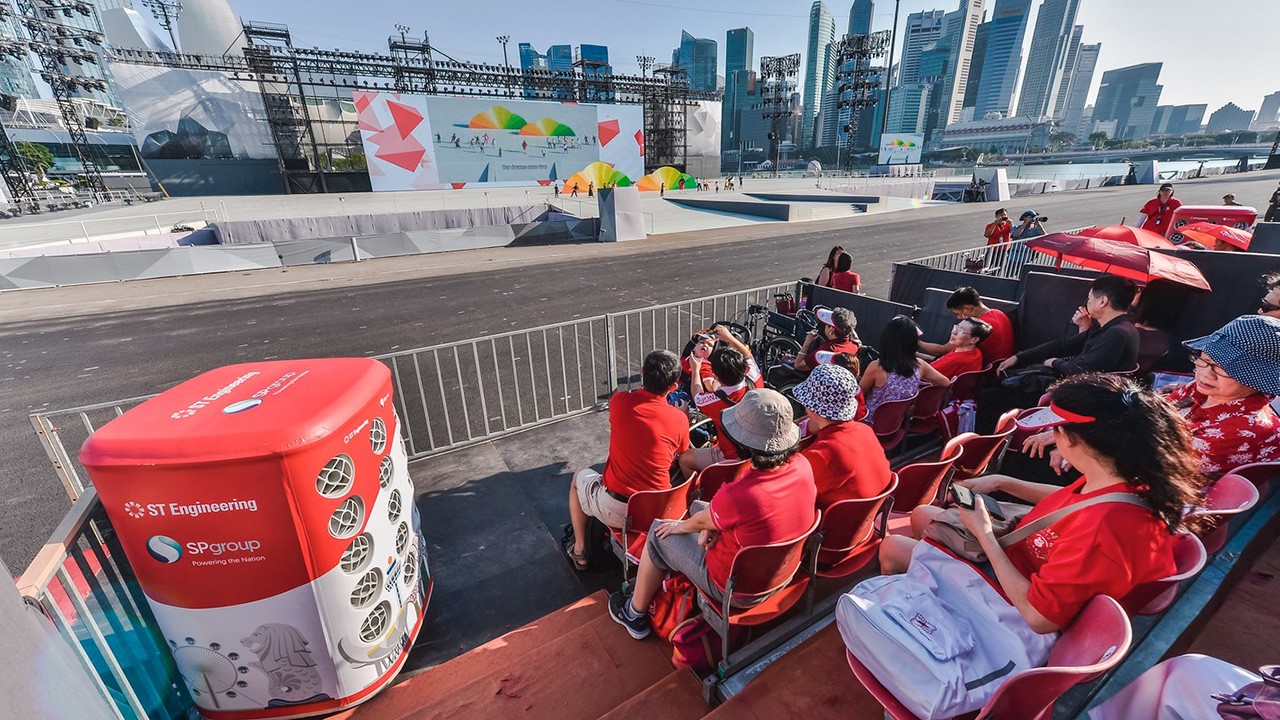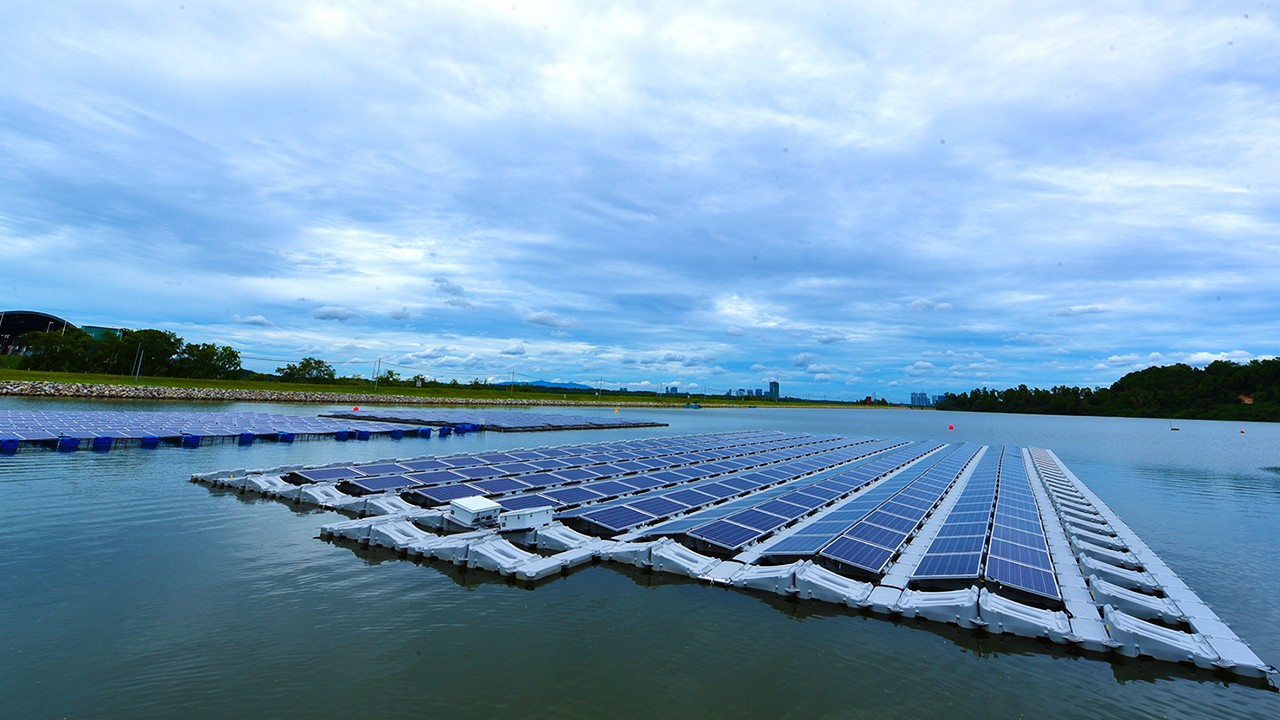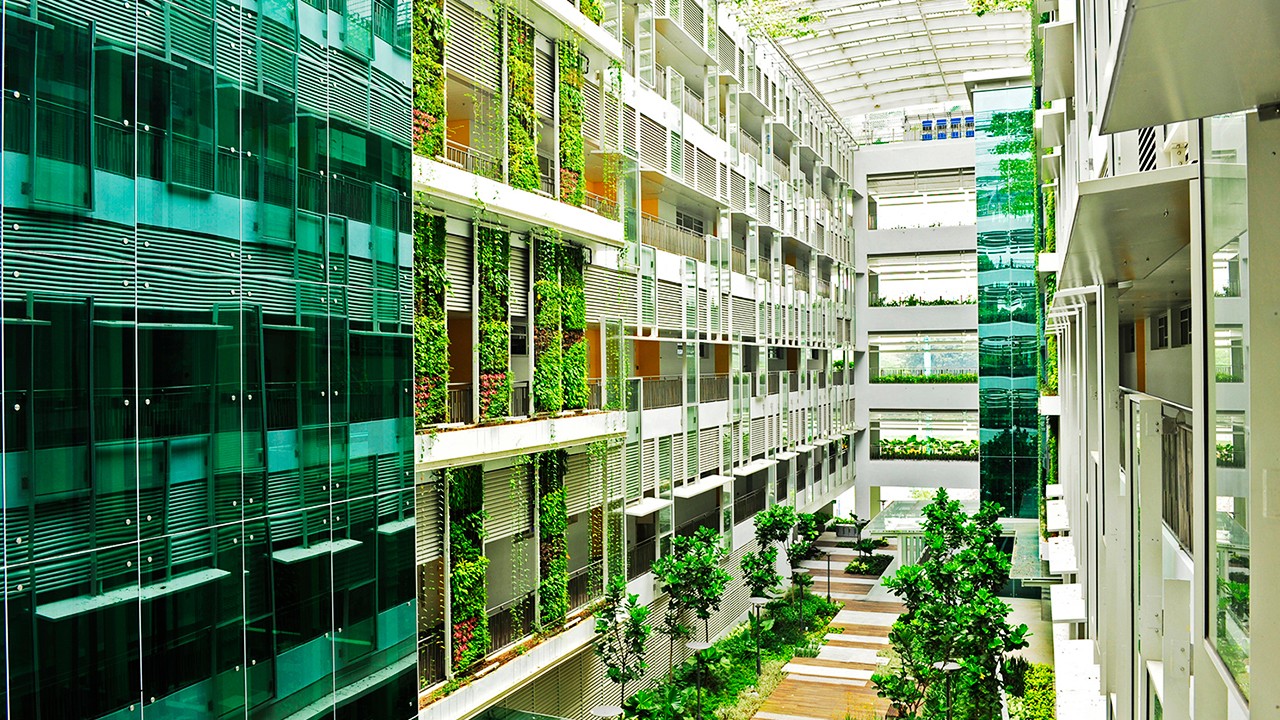3 firms winning in Singapore’s sustainable business space
Keeping public spaces cool, harnessing the power of the sun, and designing the cities of the future. Find out how three companies are innovating in the sustainability space in the tiny, resource-scarce tropical city-state of Singapore.
 Spectators on the floating platform at Marina Bay are cooled by 'recycled' cold air from a district cooling system. Image: SP Group
Spectators on the floating platform at Marina Bay are cooled by 'recycled' cold air from a district cooling system. Image: SP Group
A prosperous, sheltered dot in the heart of tropical Southeast Asia, Singapore is typically spared the wrath of nature even as its neighbours are routinely afflicted by earthquakes, cyclones, floods and droughts. But the city-state is not invulnerable to the effects of climate change.
Rises in sea level, rainfall intensity, dry spells, heat stress, flash flooding and vector-borne diseases will be accompanied by a decline in fresh water supply, food security and biodiversity in the island nation over the course of this century, if global warming is not kept in check, predicts Singapore’s National Climate Change Secretariat.
Singapore’s average temperature, which has risen from 26.6 degrees Celsius in 1972 to 27.7°C in 2014, is increasing twice as fast as the global rate.
Though daunting, these climate-related challenges have presented the most forward-thinking members of Singapore’s business community with opportunities to innovate. One such innovation will be rolled out on one of the most important days on Singapore’s national events calendar, National Day.
Chilling on National Day
As they celebrate Singapore’s 52nd birthday on August 9, a section of the crowd watching the National Day Parade fireworks and fighter jet flybys on the floating platform at Marina Bay will experience something new - outdoor air-conditioning. The 31 degrees Celsius-heat and 80 per cent humidity expected on the day will be reduced to 24 degrees in some areas of the platform.
For the first time in Singapore, the cooled air comes with a difference—it has been “recycled” from a sprawling network of underground water pipes used to chill buildings at the Marina Bay area, Singapore’s financial district.
The chilled floating platform is the latest innovation made possible by the world’s largest district cooling system, a piping network some 5 kilometres long that runs across Marina Bay. Owned and operated by Singapore’s grid operator, SP Power, it cools key landmarks including the ArtScience Museum, Marina Bay Sands and Marina Bay Financial Centre.
District cooling is the production of chilled water from a central source that is piped to a network of buildings in the local area for air conditioning, removing the need to chill buildings individually, therefore saving on energy, installation and operating costs and manpower.
SP Group, a Temasek-owned firm, estimates that the Marina Bay district cooling system has reduced energy use for building operators by 40 per cent since it started operations in 2012. The energy saved is equivalent to that needed to power 24,000 three-room public housing units.
With the temperature in Singapore increasing by 0.5 degrees Celsius every decade and the need for air conditioning increasing in parallel, the district cooling system at Marina Bay is soon to be replicated elsewhere as part of a movement to keep Singaporeans cool in an energy efficient way, says Jimmy Khoo, the managing director of Singapore District Cooling.
The aim now is to expand district cooling beyond commercial buildings, and introduce the technology to residential buildings and more outdoor spaces dotted around the island, says Khoo.
“Imagine walking around Singapore in bubbles of cooler air in various spots, delivered sustainably at low cost,” says Khoo. “We want to help unlock the potential of urban spaces and make Singapore even more liveable.”
This video details the outdoor cooling innovation:
With good planning, a clear understanding of objectives and creative thinking towards problem solving, urban development can be sustainable.
Running on sunshine
Singapore’s energy mix is dominated by natural gas, which makes more than 95 per cent of consumption and has long been seen as the most reliable, less polluting energy option. Renewables account for just a fraction of the world’s 26th biggest carbon emitter per capita. But that is changing, and a Norwegian firm named REC Solar is primed to take advantage of the trend towards clean energy.
Installed solar capacity in Singapore has almost quadrupled in the last three years- up from 33.1 megawatts peak (MWp) in 2014 to 129.8 MWp in the first quarter of 2017. The government is aiming for solar to make up 5 per cent of the country’s total energy mix - or 350 MWp - by 2020, and is on track to exceed that target, according to the Solar Energy Research Institute of Singapore.
REC Solar is riding the solar growth wave by innovating its product and service offering. Though a relatively small player, the firm competes with cheaper Chinese rivals by having the lowest claim rate in the industry; out of 1 million panels, only around 50 of REC’s are returned due to glass breakage during transport or other defects.
The company has thrived. When the firm launched a Singapore operation in 2010, it had the power capacity of 15 megawatts in solar modules. This has mushroomed in seven years, to 1.4 gigawatts.
But growth hasn’t come easy. Although the price of solar technology has dropped significantly in recent years, so has the price of fossil fuel alternatives. This is holding back investors in solar energy, believes REC Solar’s regional vice president of sales, Torgeir Ulset.
The prospects for solar are good, however. The introduction of a carbon tax in Singapore by 2019 is likely to encourage more consumers, businesses and public sector agencies to consider installing solar panels on their roofs. And by the second half of next year, Singapore’s energy sector will be fully liberalised and 1.3 million households will be able to more easily opt for renewables over fossil fuels to power their homes.
Meanwhile, solar is finding its way on to new platforms in the land-scarce island of 700 square kilometres; REC Solar is taking part in a trial of the world’s largest floating solar photovoltaic cell test bed at Tengeh Reservoir.
 REC Solar is taking part in a trial of the world’s largest floating solar test bed at Singapore’s Tengeh Reservoir. Image: Solar Energy Research Institute of Singapore
REC Solar is taking part in a trial of the world’s largest floating solar test bed at Singapore’s Tengeh Reservoir. Image: Solar Energy Research Institute of Singapore
For now though, the company must battle it out in an increasingly competitive market place. Ulset declares: “We need the best product, the most efficient service, and the best warranties and claim rates. And we need to do that at constantly lower cost point. Our biggest challenge is maintaining profitability when the price [of solar] is eroding.”
Designing a city of the future
A city that has expanded its size by a quarter over the last two centuries by reclaiming land is no stranger to the importance of planning for the long term.
“With good planning, a clear understanding of objectives and creative thinking towards problem solving, urban development can be sustainable,” Wong Heang Fine, group chief executive of urban design consultancy Surbana Jurong, tells Eco-Business.
The firm, which has developed masterplans for 90 cities and developed 50 industrial parks,believes that quality living environments can be created despite the physical limitations that exist in Singapore, and is behind some of the city-state’s most sustainable urban creations.
One iconic project is Treelodge@Punggol, a residential complex that was the first in Singapore be awarded the BCA Green Mark Platinum Award, the highests possible award in Singapore’s national green building certification scheme.
The complex was strategically placed facing the prevailing winds to maximise natural ventilation, and to minimise solar radiation. Festooned with plants to reduce heat and noise, Treelodge@Punggol’s walls, roof and courtyards are abundantly green; there is even a dedicated spot for community gardening.
Another green gem in Surbana Jurong’s portfolio is CleanTech One, is the first property to be built in Singapore’s first green business park. Like Treelodge@Punggol, the building has an east-west facing façade to maximise solar orientation, and has plentiful greenery to curb heat stress. The building also features solar panels on the roof, a bio-digester to eliminate food waste, and energy-efficient lighting throughout.
 The interior of CleanTech One. Image: Surbana Jurong
The interior of CleanTech One. Image: Surbana Jurong
Wong says that technology has given Surbana Jurong a competitive edge in sustainable design. Using building information modelling systems and virtual design and construction (VDC) combined with artificial intelligence in planning, design and construction, the firm can visualise the cities it wants to build more precisely. This enables it to better manage cost and scheduling.
The firm also uses technology to manage cities more effectively. Its smart cities solution, Smart City in a Box, enables officials to better track, monitor and manage features of the urban environment such as traffic, energy use and water quality using a dashboard of integrated applications.
“We are always mindful that what we build must be sustainable and remain relevant and attractive for both present and future generations. Hence our design considerations include social, economical and environmental aspects,” says Wong.
He adds: “Cities must be liveable and have longevity.”








